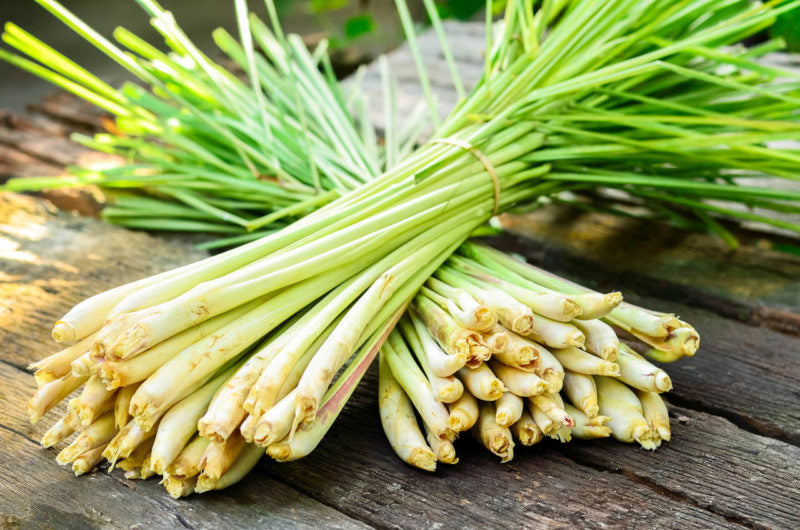Everything You Need to Know about Lemongrass (Cymbopogon citratus)
Have you ever had Southeast Asian food and tasted a sweet, lemony flavor in your sauce?
Or how about ordered a cup of “happiness tea” at your favorite tea shop and found it to be pleasantly citrus without the sour bite of lemon?
You’ve probably had lemongrass.
In culinary practice, it is known for the lemony scent and flavor it offers when you crush or cook the leaves.
Truth be told, this incredible plant has been used for hundreds of years all over the Eastern world to bring balance and comfort to our physical and mental woes. It almost always relates back to the high essential oil content (click here to watch the distillation process) with citrol being the most prominent to our noses.
If you really pay attention to the scent of organic lemongrass, like in our Co-branded Aromatherapy Mist, you can smell a touch of the sweetness that it brings too. That smell comes from the essential oil geraniol.
Notable Constituents in Lemongrass
Geraniol smells great, and that’s what we love it for, but it has another use. It’s a super strong antiseptic—that means it kills microorganisms that are trying to spread, making it effective against seasonal bacterial bugs.
Lemongrass is also a natural source of borneol, which is one of the most manufactured perfuming agents in the world and offers little bit of camphor-like spice. Borneol is wonderful for arthritic pain, stimulating digestion, and acting as a calming agent. So calming in fact, that high internal doses of pure borneol are toxic to the central nervous system so luckily this part of the plant is well balanced.
Another notable constituent found in lemongrass are the saponins. These have a long list of biological properties, including antifungal and antimicrobial actions that we see have a real effect in the use of lemongrass.
Last but certainly not least, lemongrass is a source of bioavailable silica. We need silica in our bodies, which is a type of mineral that is super abundant on our planet, but we aren’t able to process it in its natural form because our bodies can’t break it down (we literally cannot digest rocks). Lemongrass grows well in sandy, loamy soil that is rich in silica and help pull in the mineral in a way that we can process it. Cool huh?
In case we’ve really whetted your appetite, here’s more information about Lemongrass:
Lemongrass—Cymbopogon citratus
Family: poaceae (grass)
Planetary connection: Mercury
Plant Description:
- A grass that can reach up to 6ft tall.
- It has rough, “sawlike,” narrow, pointed leaves that are very long.
- The leaves grow from a bulb and the bottom is sheathed.
- The bulb is fibrous.
- The flowers grow in a bunched panicle.
Habitat: This plant is native to Southeast Asian countries but has been naturalized around the world.
How To Grow: Lemongrass thrives in hot, sunny environments with sandy soil. It can deal with full sun to full shade, but it loves water and does need a moderate amount (at least) to grow well.
Since this is a grass, the leaves are what you use to cook with. Allow it to grow and take snips of leaves as needed.
Energetics: yang, air
sour/bitter - cool - dry
Actions: antibacterial, antifungal, antioxidant, antiseptic, antispasmodic, aromatic, astringent, diaphoretic, digestive, diuretic, febrifuge, sudorific
- Balances digestion and regulates temperature by causing sweating.
Notable Constituents: vitamin C, silica, essential oils (borneol, citral, citronella, geraniol), alkaloids, monoterpene, saponins
Uses of Lemongrass:
- The essential oil of lemongrass has shown to be helpful against E. coli and Staph infections when used quickly.
- It can help prevent blood platelet aggregation, and regular tea is very good for the blood.
- The antioxidant content has lead to lemongrass being studied as a cancer preventative.
- In aromatherapy, lemongrass is used to enlivens spirit and stimulate a positive mood in people that are feeling melancholic - especially lovely when paired with hibiscus.
- Traditional uses: Cholera, Colds, Colic, Diarrhea, Fever, Flatulence, Headache, Herpes Insomnia, Parasites (nematodes), stomachache
- Often used in south Asian food to offer the lemony flavor, help to balance spice, and relieve digestive discomfort.
- Topically, lemongrass is an effective compress against arthritic pain
- Steep in the bath to soothe muscles
Other uses:
- Plant around the home to deter snakes
- In magical traditions, people used lemongrass to encourage passion.
Contraindications:
In large doses this plant can stimulate the uterus - avoid large doses when pregnant.
As with all essential oils, we do not suggest regular internal use. It is very potent and can cause lasting harm to the kidneys.
Do you have anything to add about Lemongrass? Tell us in the comments!
References:
Hoffmann, D. (2003). Medical herbalism: The science and practice of herbal medicine. Rochester, Vt.: Healing Arts Press.
Mars, B. (2007). The desktop guide to herbal medicine: The ultimate multidisciplinary reference to the amazing realm of healing plants, in a quick-study, one-stop guide. Laguna Beach, CA: Basic Health Pub.
https://acupuncturetoday.com/herbcentral/borneol.php
Photo from kohsamuiset.com


2 comments
Write a commentOlive
Could you mention what sort of nutrients it provides? As well as compost support and pest control…?
Ally
Lemon Grass is grown better in spring in cooler regions and planted in a wet season for the tropics and subtropics.